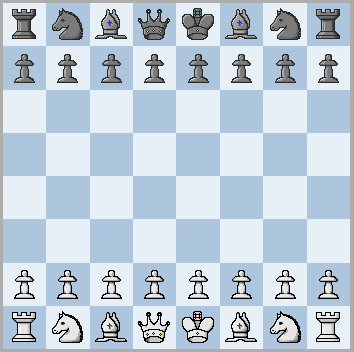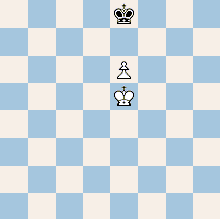

The only difference between Fide-chess 2.0 and regular chess is the extended castle rule. When castling on the kingside the king may jump three squares, but it can also jump two as usual. The rook ends up on its usual square. This change greatly enlarges the opening tree as many more opening variations become practicable. At kingside castle, it is sometimes worthwhile to place the king on a more protected square. This ought to be useful, for instance, in King’s gambit variations. However, one must keep in mind that the king is removed farther from the centre, and it no longer protects the vital f2/f7 square. Sometimes it’s better to castle normal. See also Adjutant Chess, Castle Chess, and Neoorthodox Chess.
 The king may, optionally, jump an extra square when castling kingside. The rook ends up on its usual square.
The king may, optionally, jump an extra square when castling kingside. The rook ends up on its usual square.
Discussion
Opening play is today become a straightjacket. But wouldn’t it be fun to be able to play the Jänich gambit (in Ruy Lopez) as black? If a tiny rule change can infuse life into many opening systems, I see no reason we shouldn’t adopt it.
Obviously, if this little rule change could make the King’s gambit playable again, then chess would benefit greatly. It could now be dangerous to pin the king knight, because the opponent may advance his flank pawns, provided that the king is already placed in the corner. As classical games are fully compatible with the extended castle rule (one can still make classical castle), old master games are still relevant sources of study. Remember that there are obvious disadvantages with the long king jump. The king doesn’t defend the weak f2/f7 pawn, a cornered king runs a greater risk of mate, and it is a longer way from the centre in the endgame.
Fide-chess 2.0 with revised pawn
In an alternative variant the pawn, on the seventh rank, has an additional forward capture-capability. The revised pawn, provided that it has reached the seventh rank, can also capture forwards. Due to this, passed pawns are now more dangerous. In Fide-chess 2.0 with revised pawn, drawish endgames will occur less often. Many theoretical endgames that have hitherto been drawn are now won. The additional capture-capability will also have an impact in the middlegame.
The pawn’s extra capture capability is a surprisingly simple way of introducing extra complexity. Comparatively, in orthodox chess a pawn is easy to block. This creates the marked drawishness of practical endgames. Therefore, most chessplayers prefer to keep the queen on the board, until they have created an advantage. Players can now exchange queen and enter a practical endgame, and, unlike before, the stronger player will tend to win. This is, arguably, a significant improvement compared with orthodox chess, although much analysis is needed to establish this. The new pawn is used in my Revised Chess (June 2009).
 Unlike in regular chess, this position is won regardless who makes the first move.
Unlike in regular chess, this position is won regardless who makes the first move.
• You can download my free Fide-chess 2.0 program here, but you must own the software Zillions of Games to be able to run it. (I recommend the download version.)
• Don’t miss my other chess variants.
© M. Winther, Dec 2016.